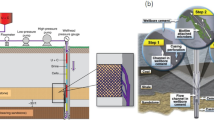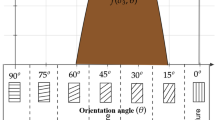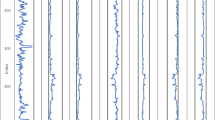Abstract
The complexity of fracture geometries impedes reliable prediction of the mechanical properties of frozen fractured rocks. Here, we combine the experimental, numerical, and machine learning methods to predict the uniaxial compressive strength and the Young’s modulus of frozen fractured rocks with five fracture geometries, including persistence factor of ice-filled fractures, spacing between the fractures, as well as inclination angle, thickness, and number of the fractures. We use the results of laboratory uniaxial compression tests to validate the numerical model and the results of two-dimensional particle flow code simulations to train the random forest (RF) models. Our study demonstrates reliable prediction of the uniaxial compressive strength and the Young’s modulus of frozen fractured rocks and compares the prediction performance with the Ramamurthy criterion. We also conduct a sensitivity analysis to reveal dominant geometries and obtain the simplified RF models with three fracture geometries (i.e., persistence factor, inclination angle, and fracture number) for similar prediction accuracy. We finally use additional experimental results to further test the reliability of the simplified RF models. The combined method can be further applied to study other mechanical properties of complex fractured rocks and is particularly suitable for the cases with limited and scattered data from the fractured rocks in experimental and field investigations.
Highlights
-
The experimental and numerical studies show how the complexity of fracture geometries influences the mechanical properties of frozen fractured rocks.
-
The combined experimental, numerical, and machine learning method is developed to predict the mechanical properties of frozen rocks with complex fracture geometries.
-
The sensitivity analysis is used to determine the dominant geometries to simplify the machine learning models for similar prediction accuracy.










Similar content being viewed by others
References
Arakawa M, Maeno N (1997) Mechanical strength of polycrystalline ice under uniaxial compression. Cold Reg Sci Technol 26(3):215–229
Breiman L (1996) Bagging predictors. Mach Learn 24(2):123–140
Breiman L (2001) Random forests. Mach Learn 45(1):5–32
Breiman L, Friedman JH, Olshen RA, Stone CJ (2017) Classification and regression trees, 1st edn. Routledge, Boca Raton
Cheung BKS, Langevin A, Delmaire H (1997) Coupling genetic algorithm with a grid search method to solve mixed integer nonlinear programming problems. Comput Math Appl 34(12):13–23
Duan K, Ji Y, Xu N, Wan Z, Wu W (2019) Excavation-induced fault instability: possible causes and implications for seismicity. Tunn Undergr Space Technol 92:103041
Fish AM, Zaretsky YK (1997) Ice strength as a function of hydrostatic pressure and temperature. CRREL Report, Cold Reg Res Eng Lab 97:1–13
Gambino GF, Harrison JP (2017) Rock engineering design in frozen and thawing rock: current approaches and future directions. Procedia Eng 191:656–665
Gruber S, Haeberli W (2007) Permafrost in steep bedrock slopes and its temperature-related destabilization following climate change. Earth Surf, J Geophys Res. https://doi.org/10.1029/2006JF000547
ISRM (1979) Suggested methods for determining the uniaxial compressive strength and deformability of rock materials. Int J Rock Mech Min Sci 16(2):135–140
Itasca (2008) Particle flow code in two dimensions, 4.0 ed. Itasca Consulting Group, Minneapolis
Ivars MD, Pierce ME, Darcel C, Reyes-Montes J, Potyondy DO, Young PR, Cundall PA (2011) The synthetic rock mass approach for jointed rock mass modelling. Int J Rock Mech Min Sci 48(2):219–244
Jaeger J (1960) Shear failure of anistropic rocks. Geol Mag 97(1):65–72
Liu Z, Xu H, Zhao Z, Chen Z (2019) DEM modeling of interaction between the propagating fracture and multiple pre-existing cemented discontinuities in shale. Rock Mech Rock Eng 52(6):1993–2001
Lu C, Cai C (2019) Challenges and countermeasures for construction safety during the Sichuan-tibet railway project. Engineering 5(5):833–838
Muhammad JS (1992) Strength of non-persistent rock joint. PhD Thesis, University of Illinois at Urbana-Champaign, Urbana
Murton JB, Peterson R, Ozouf JC (2006) Bedrock fracture by ice segregation in cold regions. Science 314(5802):1127–1129
Pedregosa F, Varoquaux G, Gramfort A, Michel V, Thirion B, Grisel O, Blondel M, Prettenhofer P, Weiss R, Dubourg V, Vanderplas J, Passos A, Cournapeau D, Brucher M, Perrot M, Duchesnay E (2011) Scikit-learn: machine learning in python. J Mach Learn Res 12:2825–2830
Plug LJ, Werner BT (2001) Fracture networks in frozen ground. J Geophys Res: Solid Earth 106(B5):8599–8613
Potyondy DO (2007) Simulating stress corrosion with a bonded-particle model for rock. Int J Rock Mech Min Sci 44(5):677–691
Potyondy DO, Cundall PA (2004) A bonded-particle model for rock. Int J Rock Mech Min Sci 41(8):1329–1364
Prudencio M, Van Sint JM (2007) Strength and failure modes of rock mass models with non-persistent joints. Int J Rock Mech Min Sci 44(6):890–902
Ramamurthy T, Arora VK (1994) Strength predictions for jointed rocks in confined and unconfined states. Int J Rock Mech Min Sci Geomech Abstr 31(1):9–22
Ramamurthy T (1993) Strength and modulus response of anisotropic rocks. Comprehensive rock engineering: principles, practice and projects. Pergamon Press, Oxford
Song Y, Tan H, Yang H, Chen S, Che Y, Chen J (2021) Fracture evolution and failure characteristics of sandstone under freeze-thaw cycling by computed tomography. Eng Geol 294:106370
Sun Z, Wang L, Zhou J, Wang C (2020) A new method for determining the hydraulic aperture of rough rock fractures using the support vector regression. Eng Geol 271:105618
Tao S, Tang X, Rutqvist J, Liu Q, Hu M (2021) The influence of stress anisotropy and stress shadow on frost cracking in rock. Comput Geotech 133:103967
Walder JS, Hallet B (1985) A theoretical model of the fracture of rock during freezing. Geol Soc Am Bull 96(3):336–346
Wang H, Xu W, Xu R (2005) Slope stability evaluation using back propagation neural networks. Eng Geol 80(3):302–315
Wang M, Wan W, Zhao Y (2020a) Prediction of the uniaxial compressive strength of rocks from simple index tests using a random forest predictive model. Comp Rend Méca 348(1):3–32
Wang Y, Feng W, Wang H, Li C, Hou Z (2020b) Rock bridge fracturing characteristics in granite induced by freeze-thaw and uniaxial deformation revealed by AE monitoring and post-test CT scanning. Cold Reg Sci Technol 177:103115
Wei M, Meng W, Dai F, Wu W (2022) Application of machine learning in predicting the rate-dependent compressive strength of rocks. J Rock Mech Geotech Eng. https://doi.org/10.1016/j.jrmge.2022.01.008
Weng L, Wu Z, Liu Q (2020) Dynamic mechanical properties of dry and water-saturated siltstones under sub-zero temperatures. Rock Mech Rock Eng 53(10):4381–4401
Wu R, Zhang Y, Guo C, Yang Z, Tang J, Su F (2020) Landslide susceptibility assessment in mountainous area: a case study of Sichuan-Tibet railway. Chin Environ Earth Sci 79(6):157
Wu Y, Li X, Zhu L (2021) Fracture mechanism of rock collapse in the freeze–thaw zone of the eastern sichuan-tibet mountains under seasonal fluctuating combinations of water and heat. Nat Hazards 108(2):2309–2333
Zhao YL, Liu Q, Zhang CS, Liao J, Lin H, Wang YX (2021) Coupled seepage-damage effect in fractured rock masses: model development and a case study. Int J Rock Mech Min Sci 144:104822
Acknowledgements
This research is supported by the National Research Foundation, Singapore, under its Virtual Singapore R&D Programme (Award No. NRF2019VSG-GMS-001).
Author information
Authors and Affiliations
Corresponding author
Additional information
Publisher's Note
Springer Nature remains neutral with regard to jurisdictional claims in published maps and institutional affiliations.
Rights and permissions
Springer Nature or its licensor holds exclusive rights to this article under a publishing agreement with the author(s) or other rightsholder(s); author self-archiving of the accepted manuscript version of this article is solely governed by the terms of such publishing agreement and applicable law.
About this article
Cite this article
Meng, W., Wu, W. Machine Learning-Aided Prediction of the Mechanical Properties of Frozen Fractured Rocks. Rock Mech Rock Eng 56, 261–273 (2023). https://doi.org/10.1007/s00603-022-03091-4
Received:
Accepted:
Published:
Issue Date:
DOI: https://doi.org/10.1007/s00603-022-03091-4




